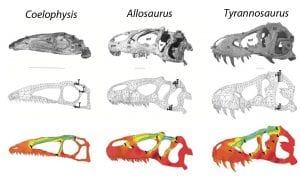Dinosaur teeth tell us what they typically could eat – the plant-eaters have peg-like or leaf-shaped teeth, and the meat-eaters had curved, pointed teeth with edges serrated like steak knives. Until recently, the best information on jaw mechanics came from simple ‘lever models’, where the jaw was modelled like a pair of scissors, pivoting on the hinge at the back. But everything has changed recently.
 [Left] Skulls and jaw function in three meat-eating dinosaurs. Image courtesy of Emily Rayfield.
[Left] Skulls and jaw function in three meat-eating dinosaurs. Image courtesy of Emily Rayfield.
Thanks to the work of Professor Emily Rayfield at the University of Bristol, palaeobiologists now use new, engineering methods. They can make a CT scan of a skull and then use the 3D digital model built from the scans as the basis for their study. The analysts apply detailed material properties to the digital model, based on the properties of bending and breaking from modern bone. So, the 3D model becomes an exact replica of the skull in life and it gives realistic answers under experimental modelling. Tyrannosaurus rex turns out to have had the greatest bite force of any known animal – ten times as powerful as the Great white shark.
Can we believe these kinds of results? Yes. If you trust yourself to fly safely in an aircraft, you accept that the engineering modelling that went into the aircraft design is reliable; palaeobologists like Emily Rayfield use exactly the same assumptions and methods.
Also, palaeobiologists have cross-checked these results using an entirely different, independent method… but you’ll have to read the book to find out what that is.

